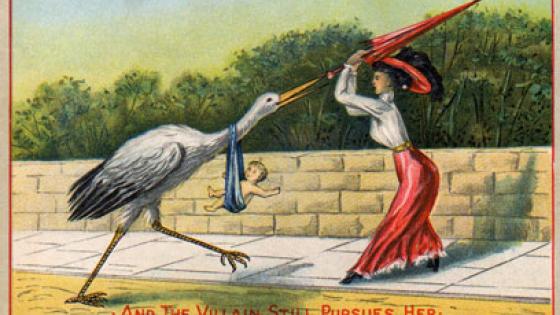"Since the best way to learn about someone else is by being together, intensive search is more effective when unwed couples spend considerable time together, perhaps including trial marriages. Yet when contraceptives are crude and unreliable, trial marriages and other premarital contact greatly raise the risk of pregnancy. The significant increase during this century in the frequency of trial marriages and other premarital contact has been in part a rational response to major improvements in contraceptive techniques, and is not decisive evidence that young people now value sexual experiences more than they did in the past."
Gary S. Becker (1991: 326)
Though fertility has been controlled for aeons, premarital sex remained risky for women until the 19th century, when contraceptive technology improved and information about contraception disseminated. Since WWII, there has been a dramatic increase in the fraction of young women who have never been married and an associated rise in the age of first marriage (both trends are shown in Figure 1). In 1900, only 48% of women aged 18-30 had never been married. By 2015, this had jumped to 77%, while the median age of a first marriage rose from 21 to 25.
Over the course of the 20th century, as contraception improved, the number of non-marital births rose continuously for reasons displayed by the right panel of Figure 2: the fraction of never-married women increased, and never-married women became more sexually active. The left panel of Figure 2 shows that non-marital births increased throughout the post-war period for women in every age group. Additionally, non-marital births for women in the adult age groups now exceed those for teenagers.
Figure 1 The fraction of women aged 18-30 that are never married, and the median age of first marriage
Figure 2 Non-marital births
Never-married women are more sexually active today than in the past, as demonstrated in Figure 3. The percentage of 20-year-old women experiencing premarital sex rose steeply over the course of the 20th century. Only 8% of women born around 1900 would have had premarital sex before age 20, compared with 76% born between 1978 and 1988. Furthermore, the circa 1900 cohort of women would have had around 2.8 sexual partners before marriage, including their husbands, while the 1978-88 cohort had 7.0 partners.
Figure 3 Premarital sex
Our work suggests that advancements in contraceptive technology led to these dramatic changes (Greenwood et. al 2019).
Historically, fertility for married women in the US was controlled, albeit imperfectly, using primitive methods of contraception. These technologies would have been too risky for unmarried women. Family size was limited by abortion, abstinence (enforced by the prohibition and stigmatisation of premarital sex), crude contraception, child abandonment and infanticide, and delaying the age of marriage (an important factor in light of short lifespans). Birth control advanced along two fronts in the 19th century (Himes 1963). First, knowledge about contraception began to disseminate. Second, contraceptive technologies improved.
Early attempts in the US to disseminate knowledge about contraceptives faced resistance. The first edition of Dr Charles Knowlton’s 1832 pamphlet The Fruits of Philosophy (whose third chapter, “Promoting and Checking Conception”, recommended douching) was published anonymously. For trying to distribute his book, Knowlton was imprisoned for three months. In 1916, Margaret Sanger opened the country’s first birth control clinic. Some 400 women received instruction about contraception before police closed the clinic nine days later. Sanger served a 30-day jail sentence in 1917. The following year, the New York State Court of Appeals ruled in The People of the State of New York v. Margaret H. Sanger that contraception could be distributed by physicians. Sanger opened the first continuously operational birth control clinic in 1923 and staffed it with female physicians and counsellors.
The 19th and 20th centuries saw improvements in condoms and spermicides, and the introduction of diaphragms, intrauterine devices (IUDs), and the combined oral contraceptive pill (‘the pill’). Early on, condoms were expensive and poorly made. Packages of a dozen rubber condoms sold for 50 cents in 1890, when a tradesman would have earned an hourly wage of 20 cents (which translates into a time price of 2.5 hours of work). A study conducted in 1934-1935 found the following distribution over defects: burst, 29.4% ; holes, 15.2%; flaws, 14.5%; total, 59.1% (Tietze 1963).
The quality of condoms had increased dramatically by the 1960s, making them one of the most effective forms of contraception. In 1846, the US Patent Office granted patent number 4,729. The patent specification included this introduction:
“Be it known that I, John B. Beers, of the city of Rochester, in the county of Monroe and State of New York, have invented a new Instrument called the ‘wife's protector’, the design of which is to Prevent conception.”
It also explicitly stated its intention to prevent pregnancy, a risky venture at the time. In the 1920s, German gynaecologist Ernst Grafenberg developed the IUD; gynaecologists Kyusaku Ogino and Hermann Knaus provided an accurate tracking of the ovulation cycle in the 1920s and 1930s. Scientists discovered and isolated hormones in the 1930s, but manufacturing them was expensive and slow. Russell Marker developed an efficient method for doing so in the 1950s. Around that time, Carl Djerassi synthesised a progestin that could be taken orally. Capitalising on these earlier breakthroughs, biologists Min Chueh Chang and Gregory Pincus teamed with obstetrician John Rock to develop the pill, which synthesises two hormones, oestrogen and progestin, to prevent ovulation. Symbolising technological improvement in contraception, the pill was approved by the US Food and Drug Administration (FDA) in 1960.
A marital search model can examine, both theoretically and quantitatively, the impact that technological innovations in contraception had on marriage. In the model economy, singles search for partners on a marriage market over a defined period. Those matched can choose to have a casual relationship or enter into marriage. There are two types of casual relationships: sexual and nonsexual. A non-marital sexual affair involves the risk of pregnancy, which depends on the effectiveness of contraception. When choosing between a casual relationship and marriage, a person calculates the marriageability of their partner versus the momentary utility from a non-marital romance followed by a continued search for a more marriageable mate. Likewise, deciding between an abstinent or a sexual relationship requires weighing the utility of having sex against the expected cost of an out-of-wedlock birth.
As the failure rate for contraception fell, the cost of a sexual relationship for single women also declined. This altered the cost/benefit calculation for marrying a partner at hand, elevating the option of postponing marriage until a more suitable partner is found. Theoretically, an improvement in contraceptive technology leads to a decline in the rate of marriage, an increase in the fraction of the population that never marries, a postponement in the age of marriage, and a rise in the fraction of sexually active singles. Out-of-wedlock births may rise or fall with advances in contraceptive technology.
The model is then calibrated to see if it can match facts from US data, such as the waning in the fraction of women who have ever been married, and the waxing in the fraction of single women who had premarital sex and out-of-wedlock births, as well as the number of sexual partners they had before marriage. The quantitative analysis focuses on two periods in US history: 1900 and 2000. An important ingredient in the calibration exercise is the failure rate for contraception, which declined dramatically starting in 1900 and moving forward to 2015-18. The failure rate gives the odds of a woman becoming pregnant if she has sex at the normal frequency for a period of one year. For each year, the series harnesses the frequency distribution over the contraceptive practices used by women. As can be seen in Figure 4, engaging in premarital sex in 1900 would have been very risky given the 72% odds of pregnancy. By 2015-18, the odds had dropped to 18%.
Figure 4 Contraceptive technology
The upshot of the calibration procedure is presented in Table 1. First, between 1900 and 2000, the median age of marriage in the US rose from 21.9 to 25.1 years. The model does a good job replicating this fact, with the mean age of marriage moving up from 21.15 to 25.44 years. In the US, a big drop can be seen between 1900 and 2000 in the percentage of 15- to 24-year-old women who were ever married; an 11 percentage point drop from 29.62 to 18.17%. The model also displays an 11 percentage point drop, but too many women are married in this age group for both periods. Additionally, the model for the year 2000 showed too few married women in the 25-to-34 and 35-to-44 age groups.
Second, single women became much more sexually active between 1900 and 2000. In the US data for 1900, only 8% of women had experienced premarital sex by age 20, 14% by age 25, and still only 26% by age 30. The model mimics this low level of sexual activity well, with the corresponding numbers being 12%, 18%, and 21%, but it overpredicts the rise in premarital sexual activity. In the 2000 data, 76% of women had engaged in premarital sex by age 20, a rise of 68 percentage points, while in the model 94% had, which represents an increase of 82 percentage points.
Third, over the period in question, out-of-wedlock births in the US shot up from 8.7 per 1,000 single women to 44.3. The model also shows a large increase, from 3.4 to 33.6. This represents an increase in the data of 35.6 pregnancies per 1,000 single women and an increase of 30.2 for the model. Additionally, single women now have sex with more partners than in the past. In 1900, a woman had on average 2.8 partners before marriage, including her future husband. The corresponding figure in the model is 1.2, when the husband is also counted. This rose to 7.0 partners in the 2000 data and to 8.2 for the model. Overall, the model does a good job explaining the targeted set of facts.
Table 1 Model versus data
Conclusions
The 19th and 20th centuries saw a transformation in contraceptive technologies and their use. The resulting ‘sexual revolution’ witnessed a rise in premarital sex and out-of-wedlock births, and a decline in marriage. To address this hypothesis, we constructed a marital search model and confronted it with data from the US. The quantitative analysis focuses on two periods in US history: 1900 and 2000. A time series measuring the efficacy of contraception shows that the odds of a pregnancy for sexually active women dropped dramatically between 1900 and 2015-18. This made sex much safer for singles. The model also helps explain, as a function of technological progress in contraception, the following set of facts: the observed decline in marriage between 1900 and 2015-18, the rise in premarital sex, the increase in out-of-wedlock births, and the uptick in the number of sexual partners before marriage.
References
Becker, G S (1991), A Treatise on the Family, Enlarged Edition, Harvard University Press: Cambridge, MA.
Greenwood, J, N Guner and K A Kopecky (2019), “The Wife’s Protector: A Quantitative Theory Linking Contraceptive Technology with the Decline in Marriage”, CEPR Discussion Paper DP14110. In preparation for Bisin, Alberto and Giovanni Federico, Eds. (forthcoming) Handbook of Historical Economics, Elsevier North Holland: Amsterdam.
Himes, N E (1936), Medical History of Contraception, Williams and Wilkins Company, Baltimore.
Tietze, C (1963), “The Condom as a Contraceptive”, Advances in Sex Research, 1 October: 88-102.











